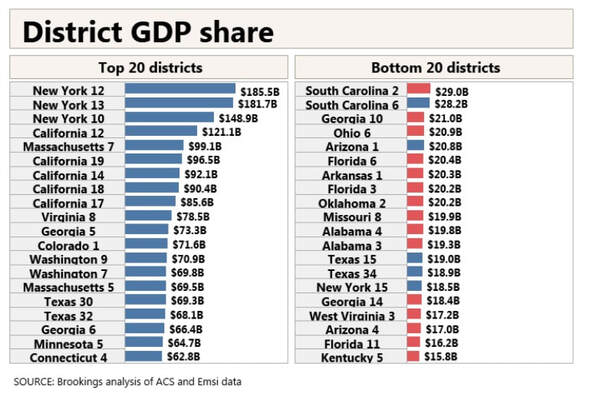|
I've meant to write about this CNBC article for a long time, ever since it was published last November 11 -- almost a year ago. But Trump keep getting in the way, and ultimately it wasn't "dated," and the point of it held true even as months passed, so I kept putting it off. But enough already. Let's finally get to it. (Hey, I may be slow, but I'm diligent...) As the article states, "These charts show how Democrats represent the growing modern economy -- and how Republicans are left behind" The point of the article is that the Red districts that Republicans represent over the "smaller, fading segment," of the U.S. economy with a work force that is "less-educated" and relies more on traditional manufacturing and resources. On the other hand, Blue districts represented by Democrats are "the larger, growing one, fueled by finance, professional services and digital innovation." This is just one of the several charts in the article and tells the point most clearly and easily --. To be clear, the point of the article -- and my addressing it -- is not to be against working men and women. After all, both sides of the discussion are working men and question. At issue is which industries are most productive and helping the most to drive the U.S. economy
The article looks at the 2016 presidential race to make the point even clearer. It notes that Trump won 2,584 counties compared to 472 counties that were won by Hillary Clinton. (To be clear, they are addressing "counties," not districts and not votes. A county is a land mass, while voting districts are broken up more equitably.) But the study by experts at the Brookings Institution showed that these significantly-fewer counties that voted for Hillary Clinton "accounted for nearly two-thirds of U.S. economic output." Brookings took their study into the 2018 House mid-term election. At the time the article was written, a few races were still yet to be decided, but they were able to break figures down by district here. And the number of districts won by Democrats in the Mid-terms accounted "for 61 percent of America's gross domestic product, [while] districts won by Republicans 38 percent. I also found one of the article's conclusions especially telling. As Brookings researcher Mark Muro notes: "The Democratic Party and Republican Party, at this point, really do occupy different economic worlds and represent different economic worlds." You can read the whole article here.
0 Comments
Leave a Reply. |
AuthorRobert J. Elisberg is a political commentator, screenwriter, novelist, tech writer and also some other things that I just tend to keep forgetting. Feedspot Badge of Honor
Archives
June 2024
Categories
All
|
|
© Copyright Robert J. Elisberg 2024
|







 RSS Feed
RSS Feed